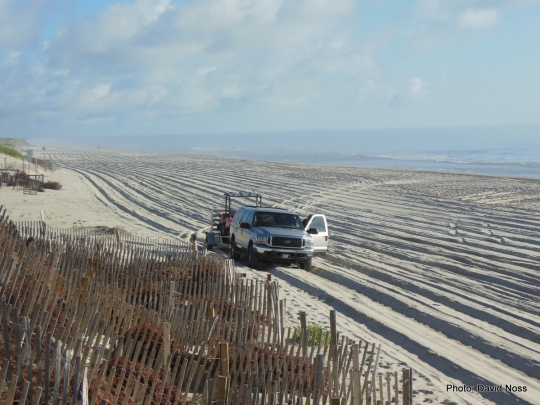 The outer Banks of North Carolina in the morning hours before the beach fills up with vehicles and people. (Photo: David Noss)
The outer Banks of North Carolina in the morning hours before the beach fills up with vehicles and people. (Photo: David Noss)It's beach season along the old Atlantic seaboard, drawing crowds of us inlanders east like our creeks and rivers. We're heading for the Bay, the beach, the Outer Banks —eager for life's troubles to evaporate between the spanking hot sand and some breakers.
But as coastal dwellers know, life's troubles are here to greet us. They've arrived in abundance, dumping down a kind of sea treasure nobody wants to find—an ancient treasure called wisdom.
These beloved beaches are disappearing as oceans rise. The very development that accommodates us beach lovers has far worsened the effect.
That's because manmade structures are rarely designed for nature's flux. They're made for human control, separation, permanence. That these goals are at odds with reality is nowhere more clear than along a beach, as any kid with a sandcastle knows.
Many rows of pricier beach castles here have collapsed, swallowed by the sea. Insurance rates and federal rescue tabs—at a cost to all taxpayers—keep soaring.
13 million displaced
One new study projects that within eight decades, 13.1 million Americans could be displaced by sea-rise. The East Coast would experience the heaviest loss. If we slow climate change, the toll could drop to 4.3 million coastal dwellers.
But climate action has formidable obstacles, namely well-heeled stakeholders and human inertia. Something in us refuses to give ground. So the coastlines have to.
In the Chesapeake Bay, shorelines—entire islands—already are disappearing. Tangier Island will likely be uninhabitable in 25 years. Its residents and the Army Corps of Engineers want multi-million-dollar funding from Congress to build new protective barriers called "breakwater
The problem, many geologists point out, is that water doesn't break—not for long. It flows. This very flexibility is the secret to its endurance.
The same is true of coastal islands. Their ability to stir allows these beaches to respond to reality, to shift, re-form themselves—and survive.
That's why, says Duke geologist Orrin Pilkey, construction solutions create their own problem. "[You can] stop the retreat of the shoreline," he says, "but you have not addressed the underlying cause of erosion. Thus the beach continues to lose sand . . . until it disappears."
The Outer Banks
Take North Carolina's Outer Banks. A perfect storm of development, sea-rise and hurricanes have long been clobbering these historic barrier islands, leaving familiar news footage.
Roads buckle, slabs of asphalt pitch sidelong into the sea, oceanfront houses get picked up and crashed down elsewhere, timbers bobbing dismally in the surf. Whatever is hard and rigid goes ker-smash. Not because nature is angry and destructive, but because nature—and these barrier islands—want to survive.
And they would if we let them, says geologist Stanley Riggs. He's been researching these Outer Banks for decades. "The only constant in dynamic coastal systems is that of change," Riggs points out.
That's why, left to themselves, these islands would respond to sea-rise by shifting westward, reshaping into vital wildlife habitat and still buffering the mainland.
But we humans don't want them to shift. We've become entrenched expensively in roads and rigid, ill-placed structures.
To continue shoring it all up, Riggs said, on these "narrow and collapsing simple barrier islands" would mean "forever fighting expensive battles"—and losing. Everyone would pay, including the beaches.
Changing our response
What's the alternative? Instead of fighting the changing seas, these geologists urge, we humans need to change our response. Riggs and Pilkey have called for a retreat from all the futile development and mitigation along these fragile beaches.
For us seashore lovers, admittedly, a retreat is hard to fathom. Would it mean an end to human presence on the shore, an end to those local economies?
On the contrary, Riggs points out, it's the only way that any economy—and the beaches themselves—can survive.
He envisions a high-tech ferry system to replace harmful and ill-fated roads, along with an eco-tourism grounded in reality and aliveness, not illusion.
Otherwise, our futile constructions, repairs and expenses amount to what geologist Pilkey regards as "beating our head against the wall."
Fond of walls
Well, we are fond of walls. We believe they will protect us. That's why Riggs, Pilkey and myriad climate scientists have met with stonewalling opposition from powerful industry lobbies and public officials entrenched in the status quo.
But our planet isn't a stasis. It flows. That's how it is able to stir us all to life. This aliveness and stir, ironically, are what we so value along the coast—and a powerful reason to be stirred in response.
Bay Journal columnist Liza Field is a hiker and conservationist. She teaches English and philosophy in the Virginia Governor's School and Wytheville Community College.


